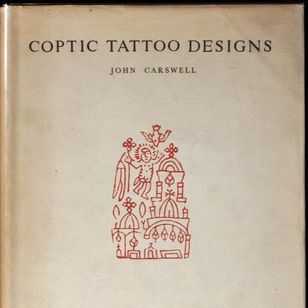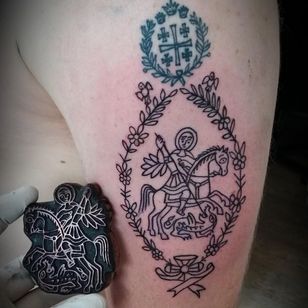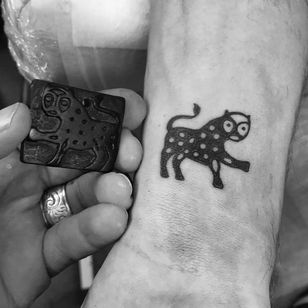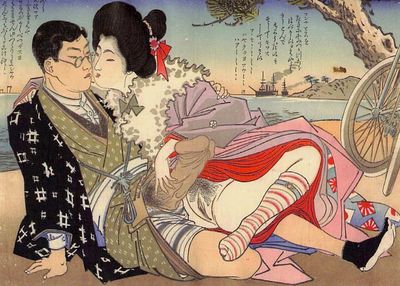Coptic Christian Tattoos: Signs of Devotion

In this article, we talk about the history and significance of Coptic Christian tattoos, as well as the ancient tattoo shop still practicing this religious art form.
In the first century, when the world was burgeoning with the flourishing of the Greek and Roman cultures, Christianity was flowing into certain sites around the developing world. Egypt was one of these sites, and the country continues to hold the largest Christian population in the Middle East and North Africa: the Copts. The Copts are an ethnoreligious group that can trace its history and foundations back to when Christianity was first introduced into Egypt, 42 AD.
But it isn’t only their fascinating connection to the genesis of Christianity, or history in general, but also their particular rituals, one of which is tattoo based. Their tattoo is not only a permanent sign of reverence for their beliefs, but it’s also one that can bring them physical safety...and even harm. Rod Waddington and Llanosom's photos below show contemporary examples of this significant cultural ritual.
In the 13th century, Copts would brand their children with a cross built of hot iron. “By the stamp of Christ, that is the crucifix, Coptic families hoped that their children would be proud enough of their religious inheritance, and sufficiently brave in a hostile Muslim society to resist any worldly temptation or pressure to convert. In fact, the Coptic cross brand was, as the cross tattoo is, a sign of defiance – a Coptic attribute that one comes across several times in various Coptic martyrologies.” This was done on the forehead, arms, and legs, and although one might recoil from the practice now, tattooing has replaced it in the modern age. The famed painting by Leon Bonnat shows an example of this dating back to the 19th century, Femme Féllah et Son Enfant, seen below.
Even as it began, the Coptic branding, whether by scarification or tattooing, was a means to define themselves, boldly, as Christians. While many of us enjoy religious freedom, the persecution of Coptic Christians in the East has been constant since ancient times and even continues now. Churches are being burned, people are being beaten, beheaded, and even a local Egyptian cop has been convicted for the shooting of a Coptic man and his teenage son.
It’s not just a meaningful tattoo that shows to the world their deepest devotion, it’s also etched into their skin for safety. Cairo based tattoo artist Mina Gerges is only 15, but he began tattooing the Coptic cross when he was 12 years old under the wing of his father, who has been doing this practice for over 27 years. “We use this cross to go into Church, and someone could use it to go in and do something bad…” Gerges mentions, citing past instances when terrorists have entered Copt worship spaces only to cause harm. And for this young tattooist, it’s a way to prove belonging, but also “a way of feeling the pain Jesus felt when he was crucified…[it’s] more than a business; it’s a service to my people.”
It isn’t only Mina Gerges who continues the tradition. Regarded as the oldest tattoo shop in the world, Razzouk Tattoo has been in business since 1300. In an interview with Chandler Lasch for the Federalist, Anton Razzouk shared the story of how his family has been tied to tattooing for generations. The hand-carved blocks that hold many of the Coptic designs were brought to the current site of Razzouk Tattoo by Anton’s grandfather. “My father used to use the wooden blocks as a stencil. He wouldn’t have to show the pilgrims a book. If you showed him which of the wooden blocks you wanted, he would put some ink on it, print it on the hand, and follow with his hand or with his electric machine.” And now Anton’s son, Wassim, is carrying on the tradition. “Only 10 years ago, I decided to continue the family tradition. I never really thought of it this way,” Wassim said. “I thought, ‘Wow, this really is important.’ My father used to tell me about it and how I should continue doing, it but I was never really interested...I feel how important it is, how beautiful it is that people appreciate the history and they come from all over the world looking for us.”
If you’re looking to get a Coptic tattoo outside of Egypt or Israel, you may have to do a little searching. Mark Newton, also known as Skin Sorcerer, is the only person in the UK known to be an ambassador of Razzouk Tattoo, as is Inkt Tattoo in Alabama USA, but there are many other tattooists who are inspired by these ancient designs. Recently Gossamer shared a piece that they had done for Sema, based on Middle Eastern flash from 1932. Mabe, based in London, also designed a print of an arm with Coptic stencils along the limb, while Timor, in Belgrade, uses the ancient designs as inspiration in his tattoos for particular clients. Seeking out artists who are directly inspired by esoteric religious symbols may be the best way to go if you aren’t ready to make the pilgrimage to Jerusalem quite yet.
For many of us, tattoos mean a great deal: they transform us into the people we want to be or know we are. They can be ritualistic, and even metaphoric for memories or philosophies we’d like to carry with us always. For the Coptic Christians, this is certainly true. Wearing their sincere piety on their bodies for all to see, they’re courageously owning their beliefs and continuing a part of tattoo history that should never be forgotten.


















